Simulating Cotton Growth and Productivity Using AquaCrop Model under Deficit Irrigation in a Semi-Arid Climate
Abstract
:1. Introduction
2. Materials and Methods
2.1. Research Area
2.2. Weather and Soil Data
2.3. Field Management and Crop Data
2.4. Calibration of AquaCrop Model
2.5. Model Evaluation
3. Results
3.1. Model Calibration
3.2. Model Validation
3.3. Water Productivity
4. Discussion
5. Conclusions
Author Contributions
Funding
Institutional Review Board Statement
Informed Consent Statement
Data Availability Statement
Acknowledgments
Conflicts of Interest
References
- GoP. Economic Survey of Pakistan. 2018. Available online: http://finance.gov.pk/survey_0708.html (accessed on 14 November 2019).
- Howell, T.A. Enhancing water use efficiency in irrigated agriculture. Agron. J. 2001, 93, 281–289. [Google Scholar] [CrossRef] [Green Version]
- Steduto, P.; Hsiao, T.C.; Raes, D.; Fereres, E. AquaCrop—The FAO crop model to simulate yield response to water: I. Concepts and underlying principles. Agron. J. 2009, 101, 426–437. [Google Scholar]
- Mumtaz, H.; Farhan, M.; Amjad, M.; Riaz, F.; Kazim, A.H.; Sultan, M.; Farooq, M.; Mujtaba, M.A.; Hussain, I.; Imran, M. Biomass waste utilization for adsorbent preparation in CO2 capture and sustainable environment applications. Sustain. Energy Technol. Assess. 2021, 46, 101288. [Google Scholar]
- Tsakmakis, I.D.; Kokkos, N.P.; Gikas, G.D.; Pisinaras, V.; Hatzigiannakis, E.; Arampatzis, G.; Sylaios, G.K. Evaluation of AquaCrop model simulations of cotton growth under deficit irrigation with an emphasis on root growth and water extraction patterns. Agric. Water Manag. 2019, 213, 419–432. [Google Scholar]
- Jin, X.; Yang, G.; Li, Z.; Xu, X.; Wang, J.; Lan, Y. Estimation of water productivity in winter wheat using the AquaCrop model with field hyperspectral data. Precis. Agric. 2018, 19, 1–17. [Google Scholar]
- Salemi, H.R.; Salehi, M. Effects of limited irrigation on grain yield, yield Components and qualitative traits of some new wheat cultivars. Asian J. Plant Sci. 2005, 8, 74–77. [Google Scholar]
- Ashraf, M.N.; Mahmood, M.H.; Sultan, M.; Banaeian, N.; Usman, M.; Ibrahim, S.M. Investigation of Input and Output Energy for Wheat Production: A Comprehensive Study for Tehsil Mailsi (Pakistan). Sustainability 2020, 12, 6884. [Google Scholar] [CrossRef]
- Qureshi, A.S.; McCornick, P.G.; Qadir, M.; Aslam, Z. Managing salinity and waterlogging in the Indus Basin of Pakistan. Agric. Water Manag. 2008, 95, 1–10. [Google Scholar] [CrossRef]
- García-Vila, M.H.; Fereres, L.; Mateos, F.; Orgaz, F.; Steduto, P. Deficit irrigation optimization of cotton with AquaCrop. Agron. J. 2009, 101, 477–487. [Google Scholar]
- Farahani, H.J.; Izzi, G.; Oweis, T.Y. Parameterization and evaluation of the AquaCrop model for full and deficit irrigated cotton. Agron. J. 2009, 101, 469–476. [Google Scholar]
- Salemi, H.; Mohd-Soom, M.A.; Lee, T.S.; Mousavi, S.F.; Ganji, A.; Yusoff, M.K. Application of AquaCrop model in deficit irrigation management of Winter wheat in arid region. Afr. J. Agric. Res. 2011, 610, 2204–2215. [Google Scholar]
- Abedinpour, M.; Sarangi, A.; Rajput, T.; Singh, M.; Pathak, H.; Ahmad, T. Performance evaluation of AquaCrop model for maize crop in a semi-arid environment. Agric. Water Manag. 2012, 110, 55–66. [Google Scholar] [CrossRef]
- GoP. Economic Survey of Pakistan. 2019. Available online: http://finance.gov.pk/survey_0708.html (accessed on 24 March 2020).
- Hossain, M.A.; Hassan, M.S.; Ahmmed, S.; Islam, M.S. Solar pump irrigation system for green agriculture. Agric. Eng. Int. CIGR J. 2014, 16, 1–15. [Google Scholar]
- Askalany, A.; Ali, E.S.; Mohammed, R.H. A novel cycle for adsorption desalination system with two stages-ejector for higher water production and efficiency. Desalination 2020, 496, 114753. [Google Scholar] [CrossRef]
- Riaz, N.; Sultan, M.; Miyazaki, T.; Shahzad, M.W.; Farooq, M.; Sajjad, U.; Niaz, Y. A review of recent advances in adsorption desalination technologies. Int. Commun. Heat Mass Transf. 2021, 128, 105594. [Google Scholar] [CrossRef]
- Aziz, M.; Rizvi, S.A.; Iqbal, M.A.; Syed, S.; Ashraf, M.; Anwer, S.; Usman, M.; Tahir, N.; Khan, A.; Asghar, S. A Sustainable Irrigation System for Small Landholdings of Rainfed Punjab, Pakistan. Sustainability 2021, 13, 11178. [Google Scholar] [CrossRef]
- Babel, M.S.; Deb, P.; Soni, P. Performance evaluation of AquaCrop and DSSAT-CERES for maize under different irrigation and manure application rates in the Himalayan region of India. Agric. Res. 2019, 8, 207–217. [Google Scholar] [CrossRef]
- Raes, D.; Steduto, P.; Hsiao, T.C.; Fereres, E. AquaCrop—the FAO crop model to simulate yield response to water: II. Main algorithms and software description. Agron. J. 2009, 101, 438–447. [Google Scholar] [CrossRef] [Green Version]
- Jin, X.; Feng, H.; Zhu, X.; Li, Z.; Song, S.; Song, X. Assessment of the AquaCrop model for use in simulation of irrigated winter wheat canopy cover, biomass, and grain yield in the North China Plain. PLoS ONE 2014, 9, 1–11. [Google Scholar] [CrossRef]
- Allen, R.G.; Pereira, L.S.; Raes, D.; Smith, M. Crop evapotranspiration—Guidelines for computing crop water requirements—FAO Irrigation and drainage paper 56. Fao Rome 1998, 300, D05109. [Google Scholar]
- Neina, D. The role of soil pH in plant nutrition and soil remediation. Appl. Environ. Soil Sci. 2019, 2019, 1–9. [Google Scholar] [CrossRef]
- Stewart, A.M.; Edmisten, K.L.; Wells, R.; Collins, G.D. Measuring canopy coverage with digital imaging. Commun. Soil Sci. Plant Anal. 2007, 38, 895–902. [Google Scholar] [CrossRef]
- Cardinali, A.; Nason, G. Costationarity of locally stationary time series using costat 55. J. Stat Soft. 2013, 55, 1–22. [Google Scholar] [CrossRef] [Green Version]
- Li, J.; Inanaga, S.; Li, Z.; Eneji, A.E. Optimizing irrigation scheduling for winter wheat in the North China Plain. Agric. Water Manag. 2005, 76, 8–23. [Google Scholar] [CrossRef]
- Giuliani, M.; Li, Y.; Castelletti, A.; Gandolfi, C. A coupled human-natural systems analysis of irrigated agriculture under changing climate. Water Resour. Res. 2016, 52, 6928–6947. [Google Scholar] [CrossRef]
- Loague, K.; Green, R.E. Statistical and graphical methods for evaluating solute transport models: Overview and application. J. Contam. Hydrol. 1991, 7, 51–73. [Google Scholar] [CrossRef]
- Greaves, G.E.; Wang, Y.-M. Assessment of FAO AquaCrop model for simulating maize growth and productivity under deficit irrigation in a tropical environment. Water 2016, 8, 557. [Google Scholar] [CrossRef]
- Zeleke, K.T.; Luckett, D.; Cowley, R. Calibration and testing of the FAO AquaCrop model for canola. Agron. J. 2011, 103, 1610–1618. [Google Scholar] [CrossRef]
- Evett, S.R.; Tolk, J.A. Introduction: Can water use efficiency be modeled well enough to impact crop management? Agron. J. 2009, 101, 423–425. [Google Scholar] [CrossRef]
- Asghar, N.; Akram, N.A.; Ameer, A.; Shahid, H.; Kausar, S.; Asghar, A.; Idrees, T.; Mumtaz, S.; Asfahan, H.M.; Sultan, M. Foliar-applied hydrogen peroxide and proline modulates growth, yield and biochemical attributes of wheat (Triticum aestivum L.) Under varied n and p levels. Fresenenius Environ. Bul. 2021, 30, 5445–5465. [Google Scholar]
- Heidarinia, M.; Naseri, A.; Broumandnasab, S.; Azari, A. Assessing AquaCrop model application in irrigation management innorth of Khosetan_Safiabad(CD). In Proceedings of the 1st National Water Management in Farm Conference, Karaj, Iran, 30–31 May 2012. [Google Scholar]
- Paredes, P.; Wei, Z.; Liu, Y.; Xu, D.; Xin, Y.; Zhang, B.; Pereira, L.S. Performance assessment of the FAO AquaCrop model for soil water, soil evaporation, biomass and yield of soybeans in North China Plain. Agric. Water Manag. 2015, 152, 57–71. [Google Scholar]
- Ahmadi, S.H.; Mosallaeepour, E.; Kamgar-Haghighi, A.A.; Sepaskhah, A.R. Modeling maize yield and soil water content with AquaCrop under full and deficit irrigation managements. Water Resour. Manag. 2015, 29, 2837–2853. [Google Scholar]
- Ahmad, H.S.; Imran, M.; Ahmad, F.; Rukh, S.; Ikram, R.M.; Rafique, H.M.; Iqbal, Z.; Alsahli, A.A.; Alyemeni, M.N.; Ali, S. Improving water use efficiency through reduced irrigation for sustainable cotton production. Sustainability 2021, 13, 4044. [Google Scholar]
- Katerji, N.; Campi, P.; Mastrorilli, M. Productivity, evapotranspiration, and water use efficiency of corn and tomato crops simulated by AquaCrop under contrasting water stress conditions in the Mediterranean region. Agric. Water Manag. 2013, 130, 14–26. [Google Scholar]
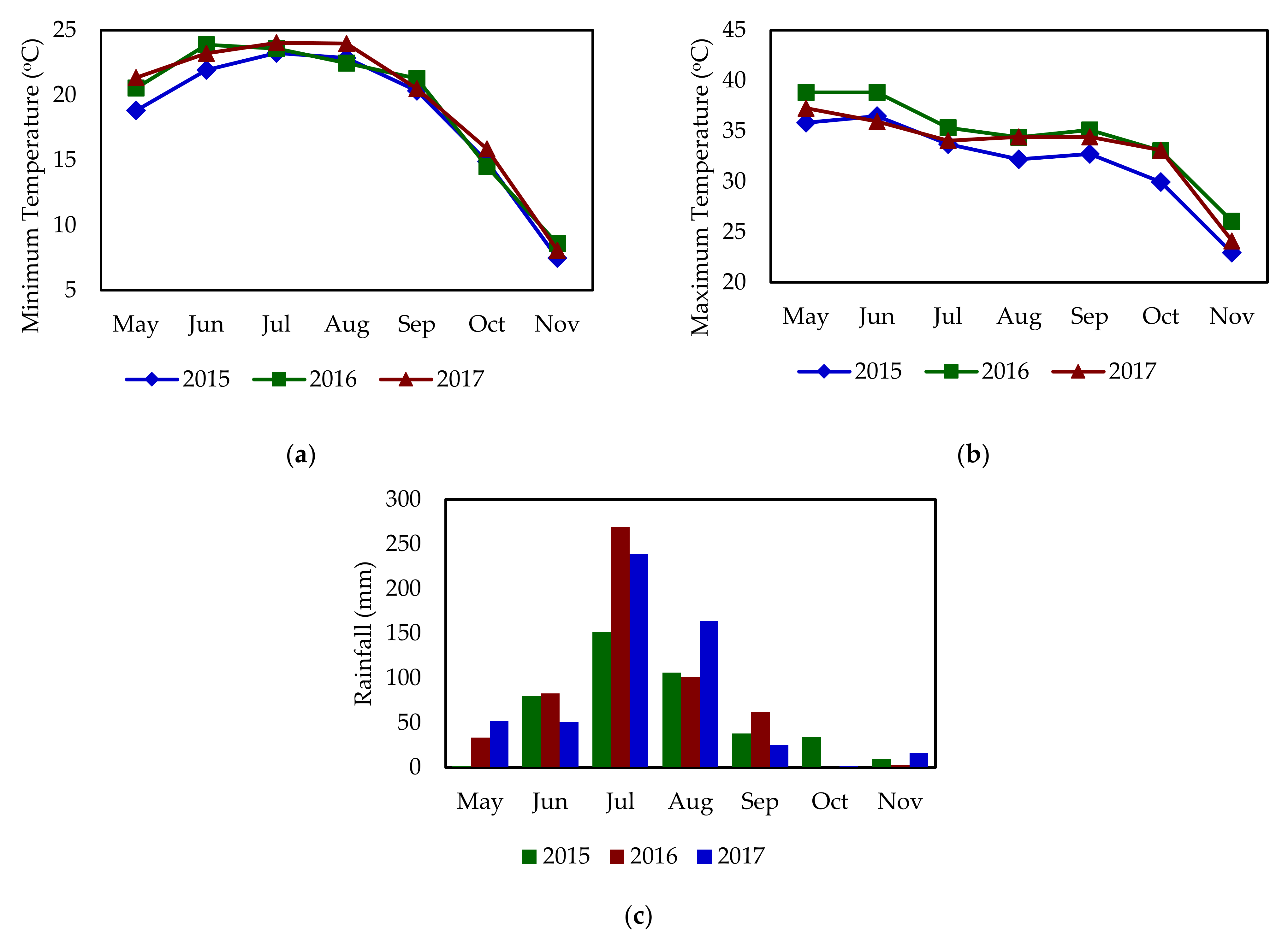
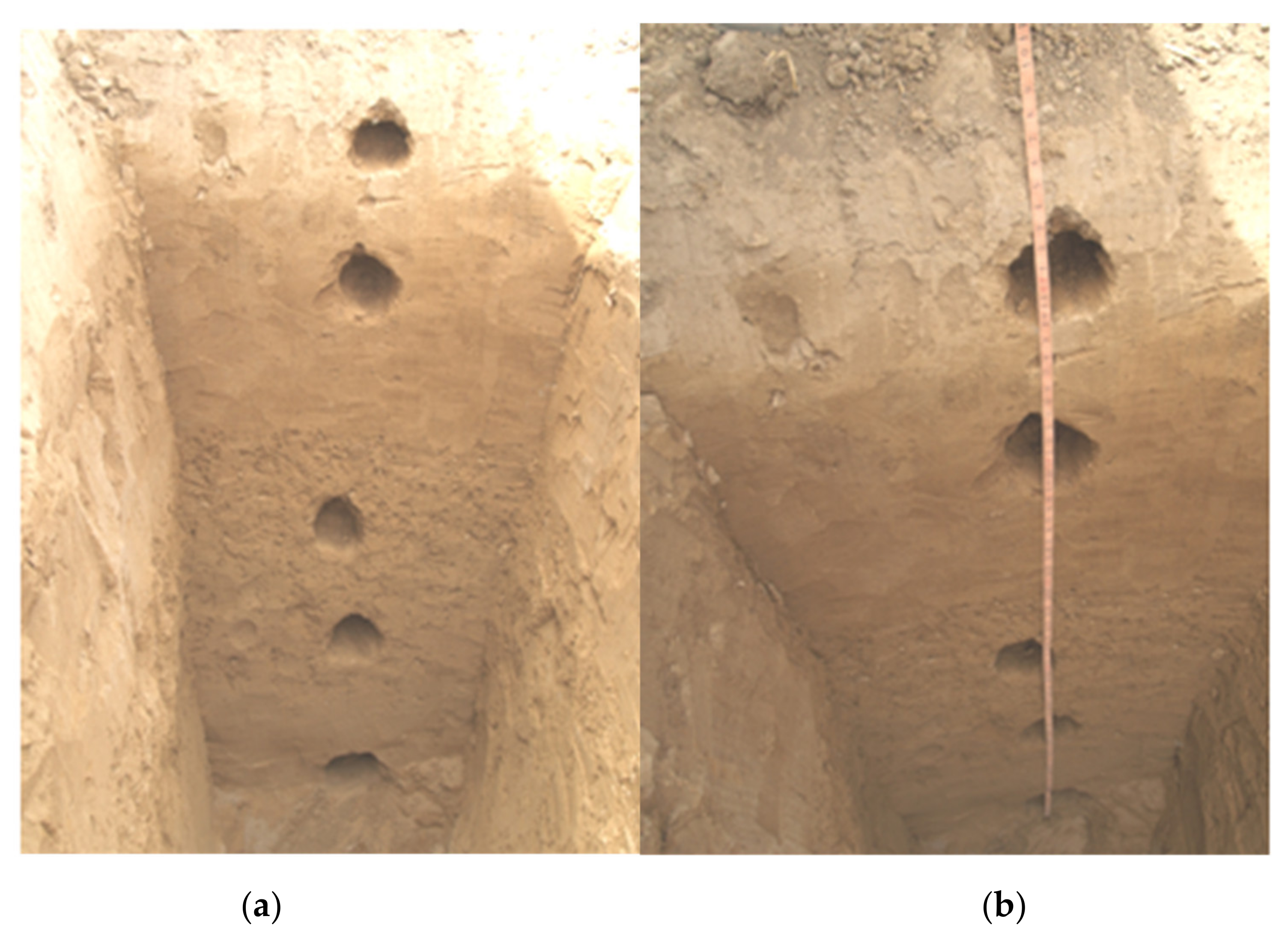
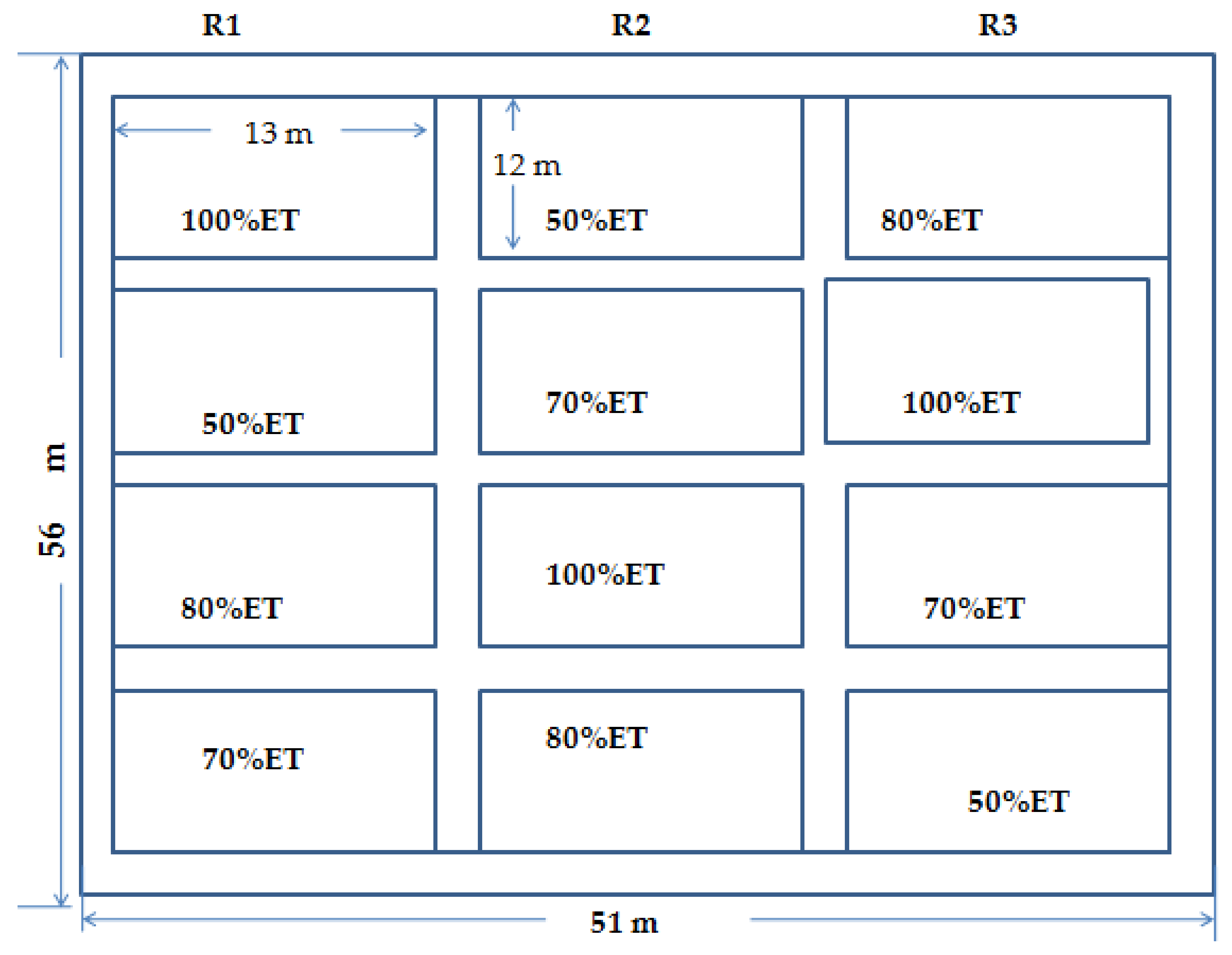
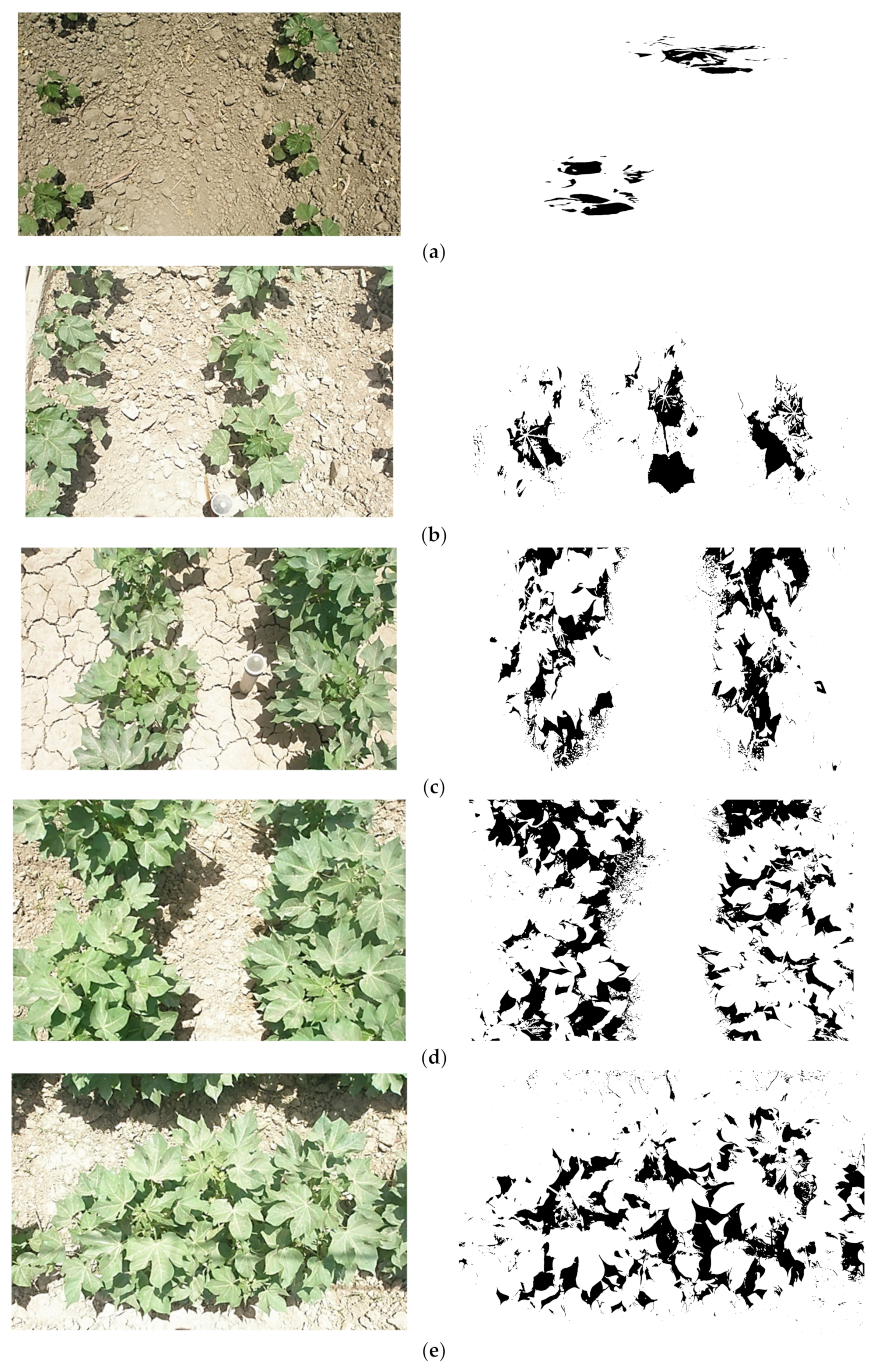
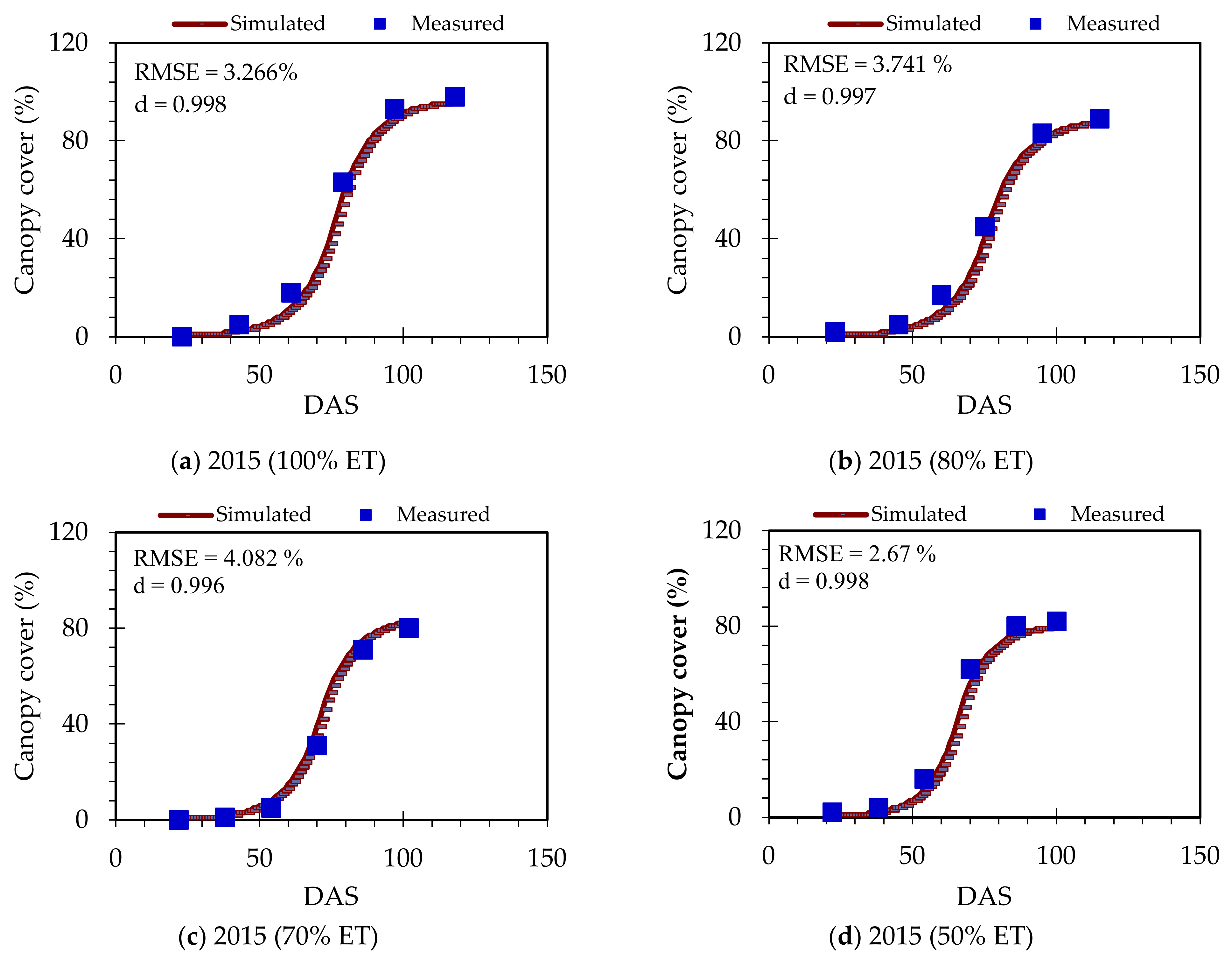
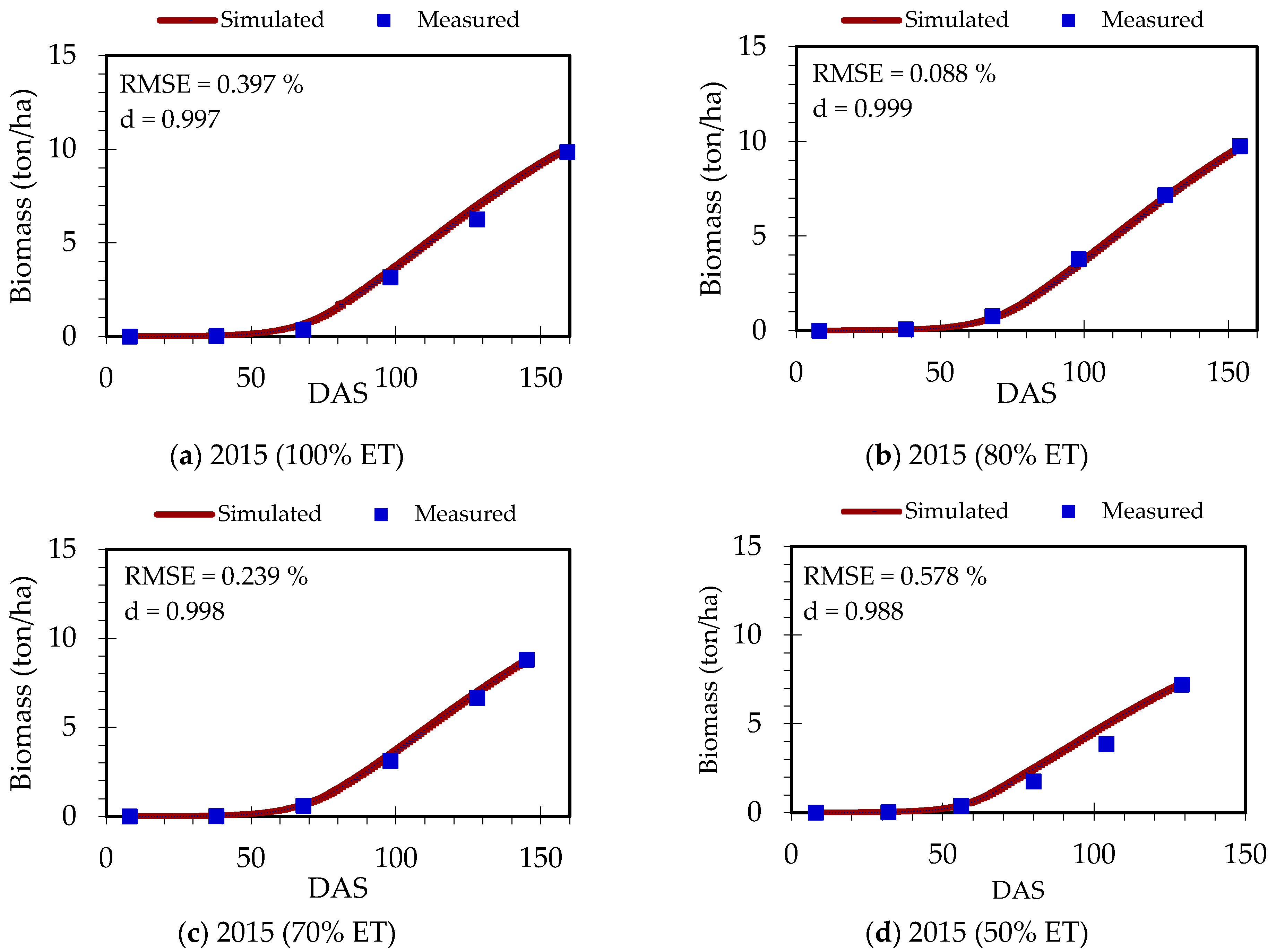
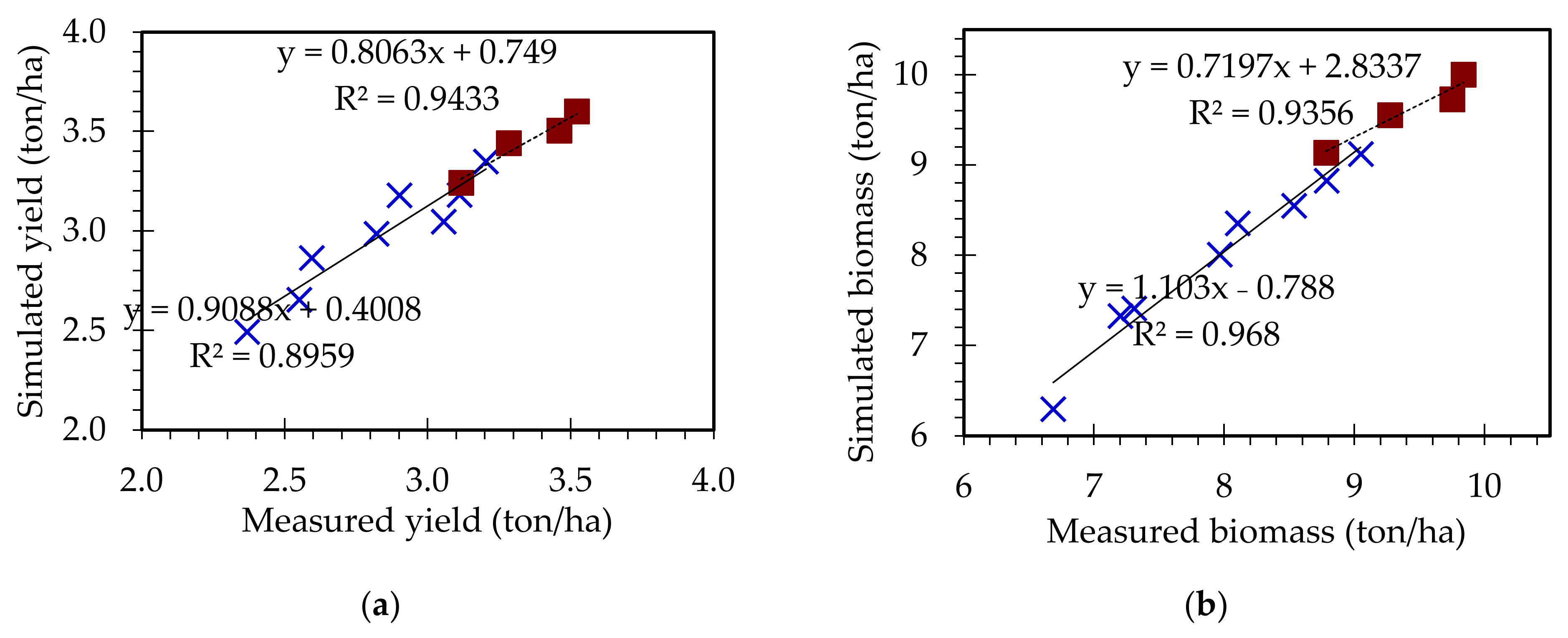

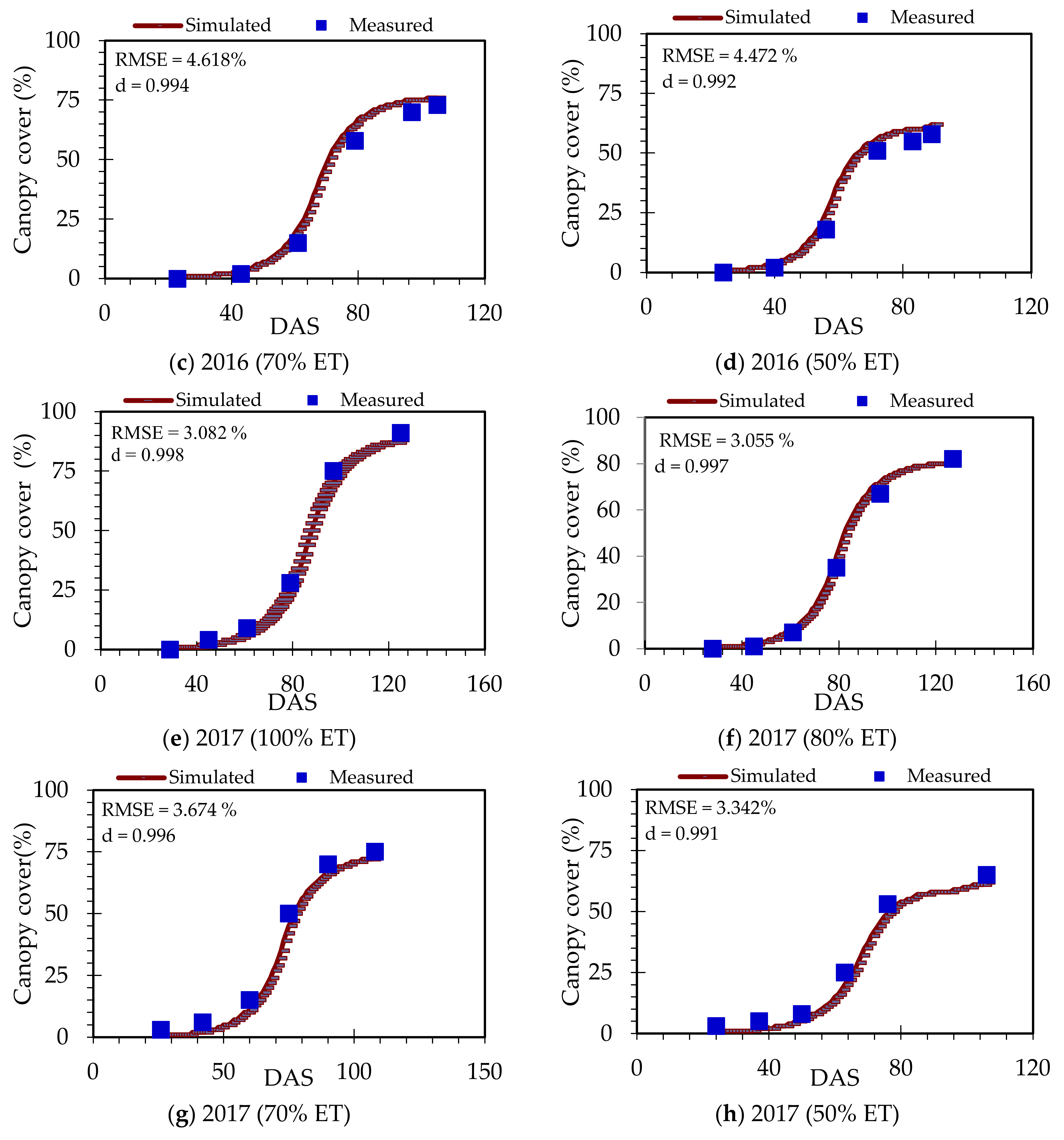
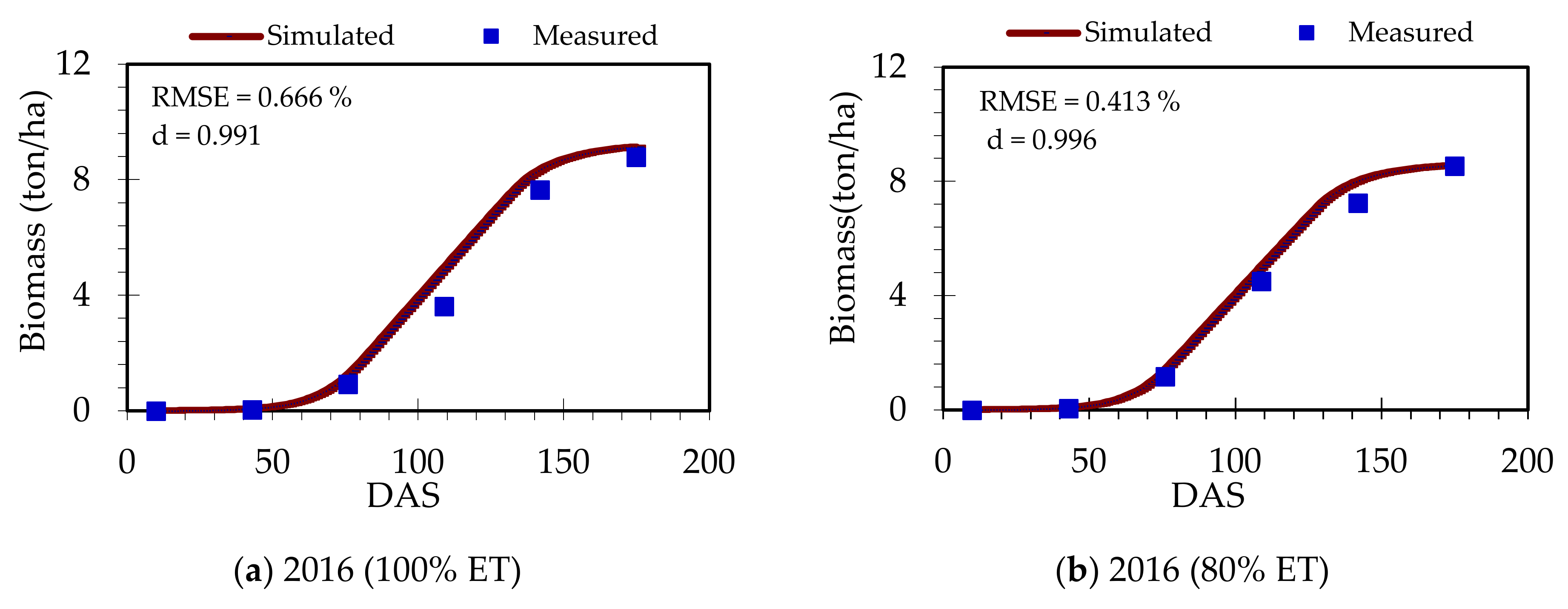
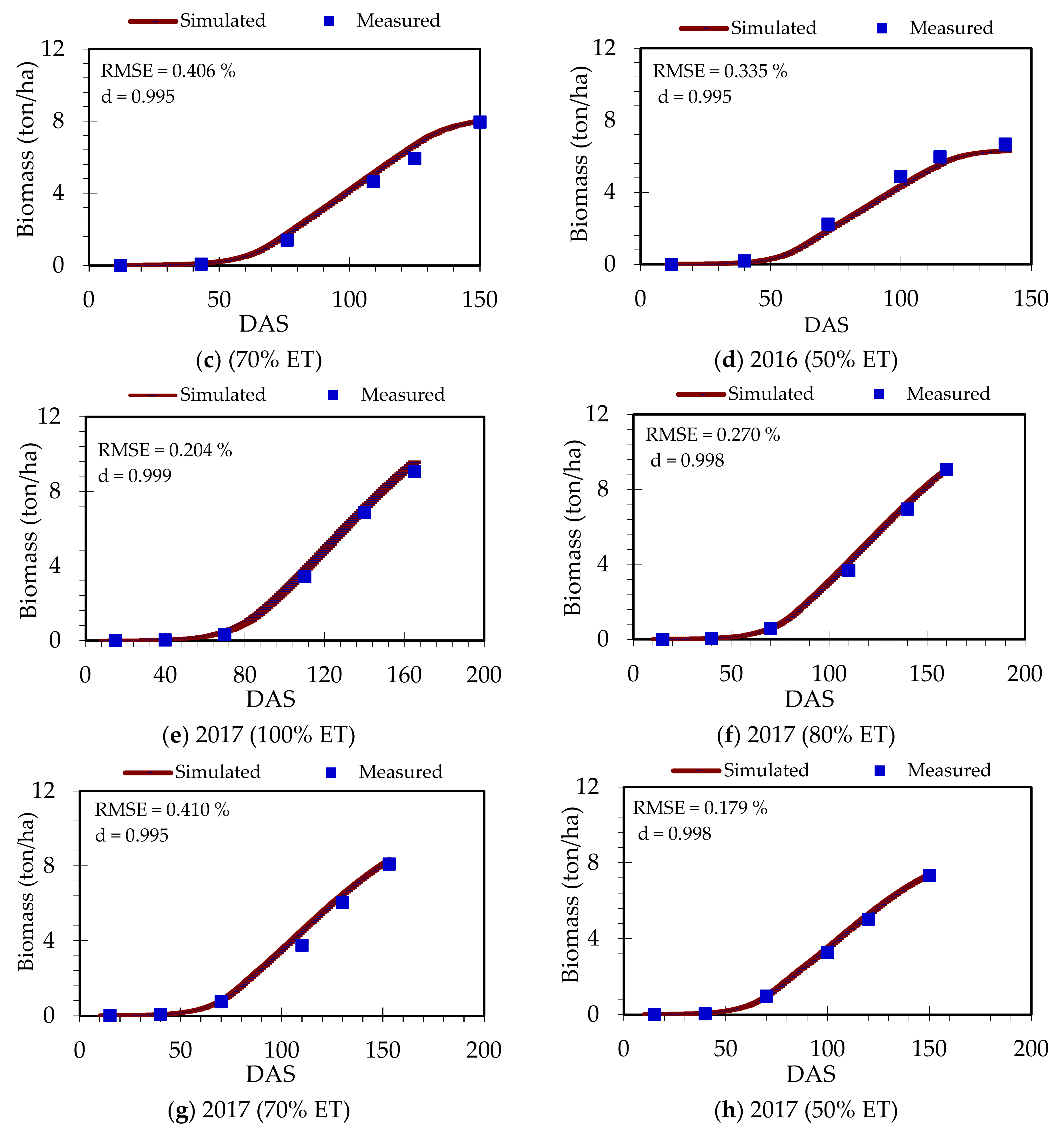

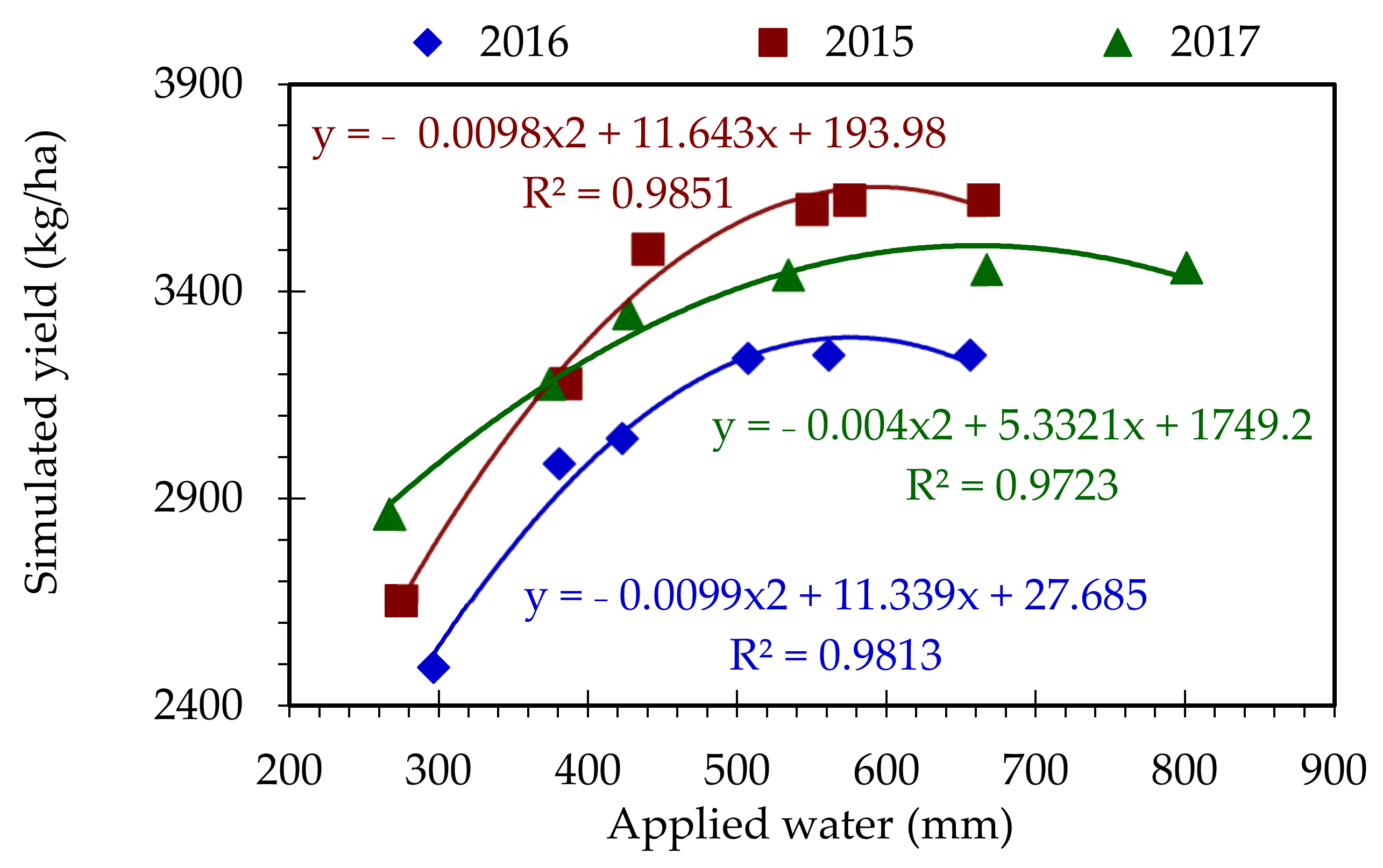
| Depth | Texture | Bulk Density | Ksat | Organic Carbon | Clay | Silt | Nitrogen | FC | pH in Water |
|---|---|---|---|---|---|---|---|---|---|
| (m) | - | (g/cm3) | (mm/day) | (%) | (%) | (%) | (%) | m3 m−3 | - |
| 0–0.3 | Sandy loam | 1.52 | 0.75 | 0.45 | 6 | 16 | 0.04 | 0.10 | 9.1 |
| 0.3–0.6 | Sandy loam | 1.7 | 0.6 | 0.35 | 14 | 8 | 0.02 | 0.13 | 9.1 |
| 0.6–0.9 | Sandy loam | 1.6 | 0.8 | 0.2 | 6 | 20 | 0.02 | 0.15 | 8.9 |
| 0.9–1.2 | Sandy loam | 1.39 | 0.83 | 0.02 | 8 | 22 | 0.02 | 0.18 | 8.9 |
| Agronomic Details | Growing Seasons | ||
|---|---|---|---|
| 2015 | 2016 | 2017 | |
| Plant population (plants/ha) | 29,240 | 27,240 | 27,533 |
| Date of sowing (DAS) | 15-May | 21-May | 15-May |
| Emergence (DAS) | 7 | 9 | 8 |
| Flowering (DAS) | 55 | 57 | 60 |
| Senescence (DAS) | 121 | 133 | 135 |
| Maturity (DAS) | 160 | 175 | 165 |
| Maximum rooting depth (cm) | 102 | 104 | 102 |
| Amount of irrigation water applied (m3/ha) | |||
| 100%ET | 5500 | 5070 | 5340 |
| 80%ET | 4400 | 4230 | 4270 |
| 70%ET | 3850 | 3810 | 3740 |
| 50%ET | 2750 | 2970 | 2670 |
| Treatments | Variables | Measured | Simulated | Deviation (%) |
|---|---|---|---|---|
| 100%ET | Biomass (ton/ha) | 9.837 | 10.002 | 2 |
| Yield (ton/ha) | 3.521 | 3.6 | 2 | |
| 80%ET | Biomass (ton/ha) | 9.75 | 9.729 | 0 |
| Yield (ton/ha) | 3.46 | 3.503 | 1 | |
| 70%ET | Biomass (ton/ha) | 8.785 | 8.83 | 1 |
| Yield (ton/ha) | 3.11 | 3.179 | 2 | |
| 50%ET | Biomass (ton/ha) | 7.201 | 7.328 | 2 |
| Yield (ton/ha) | 2.55 | 2.654 | 4 |
| Treatments | Variables | 2016 | 2017 | ||||
|---|---|---|---|---|---|---|---|
| Measured | Simulated | Deviation (%) | Measured | Simulated | Deviation (%) | ||
| 100% ET | Biomass (ton/ha) | 8.78 | 9.136 | 4 | 9.271 | 9.556 | 3 |
| Yield (ton/ha) | 3.116 | 3.24 | 4 | 3.282 | 3.441 | 5 | |
| 80% ET | Biomass (ton/ha) | 8.534 | 8.551 | 0 | 9.046 | 9.126 | 1 |
| Yield (ton/ha) | 3.055 | 3.046 | 0 | 3.203 | 3.347 | 4 | |
| 70% ET | Biomass (ton/ha) | 7.963 | 8.007 | 1 | 8.102 | 8.358 | 3 |
| Yield (ton/ha) | 2.82 | 2.985 | 6 | 2.900 | 3.177 | 10 | |
| 50% ET | Biomass (ton/ha) | 6.685 | 6.298 | −6 | 7.308 | 7.413 | 1 |
| Yield (ton/ha) | 2.367 | 2.493 | 5 | 2.593 | 2.863 | 10 | |
| Treatments | Yield Water Productivity (YiWP) (kg/m3) | Biomass Water Productivity (BiWP) (kg/m3) | ||||
|---|---|---|---|---|---|---|
| Measured | Simulated | Deviation (%) | Measured | Simulated | Deviation (%) | |
| 2015 | ||||||
| 100%ET | 0.57 | 0.59 | 4 | 1.79 | 1.8 | 1 |
| 80%ET | 0.58 | 0.59 | 2 | 1.78 | 1.83 | 3 |
| 70%ET | 0.51 | 0.55 | 8 | 1.72 | 1.78 | 4 |
| 50%ET | 0.46 | 0.51 | 10 | 1.58 | 1.65 | 5 |
| 2016 | ||||||
| 100%ET | 0.63 | 0.65 | 3 | 1.75 | 1.79 | 2 |
| 80%ET | 0.63 | 0.63 | 0 | 1.75 | 1.77 | 1 |
| 70%ET | 0.53 | 0.58 | 9 | 1.67 | 1.72 | 3 |
| 50%ET | 0.50 | 0.54 | 9 | 1.53 | 1.59 | 4 |
| 2017 | ||||||
| 100%ET | 0.58 | 0.57 | −2 | 1.68 | 1.7 | 1 |
| 80%ET | 0.59 | 0.6 | 3 | 1.69 | 1.65 | −2 |
| 70%ET | 0.50 | 0.53 | 6 | 1.57 | 1.63 | 4 |
| 50%ET | 0.43 | 0.48 | 11 | 1.44 | 1.5 | 4 |
Publisher’s Note: MDPI stays neutral with regard to jurisdictional claims in published maps and institutional affiliations. |
© 2022 by the authors. Licensee MDPI, Basel, Switzerland. This article is an open access article distributed under the terms and conditions of the Creative Commons Attribution (CC BY) license (https://creativecommons.org/licenses/by/4.0/).
Share and Cite
Aziz, M.; Rizvi, S.A.; Sultan, M.; Bazmi, M.S.A.; Shamshiri, R.R.; Ibrahim, S.M.; Imran, M.A. Simulating Cotton Growth and Productivity Using AquaCrop Model under Deficit Irrigation in a Semi-Arid Climate. Agriculture 2022, 12, 242. https://doi.org/10.3390/agriculture12020242
Aziz M, Rizvi SA, Sultan M, Bazmi MSA, Shamshiri RR, Ibrahim SM, Imran MA. Simulating Cotton Growth and Productivity Using AquaCrop Model under Deficit Irrigation in a Semi-Arid Climate. Agriculture. 2022; 12(2):242. https://doi.org/10.3390/agriculture12020242
Chicago/Turabian StyleAziz, Marjan, Sultan Ahmad Rizvi, Muhammad Sultan, Muhammad Sultan Ali Bazmi, Redmond R. Shamshiri, Sobhy M. Ibrahim, and Muhammad A. Imran. 2022. "Simulating Cotton Growth and Productivity Using AquaCrop Model under Deficit Irrigation in a Semi-Arid Climate" Agriculture 12, no. 2: 242. https://doi.org/10.3390/agriculture12020242
APA StyleAziz, M., Rizvi, S. A., Sultan, M., Bazmi, M. S. A., Shamshiri, R. R., Ibrahim, S. M., & Imran, M. A. (2022). Simulating Cotton Growth and Productivity Using AquaCrop Model under Deficit Irrigation in a Semi-Arid Climate. Agriculture, 12(2), 242. https://doi.org/10.3390/agriculture12020242








